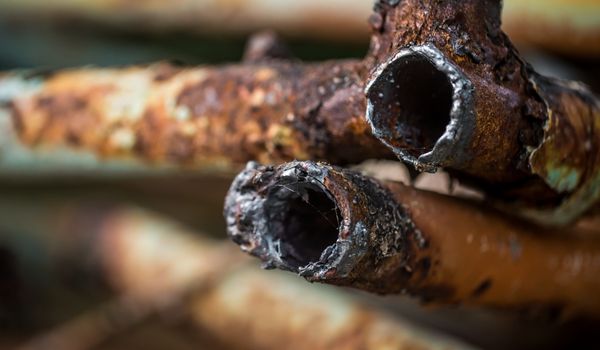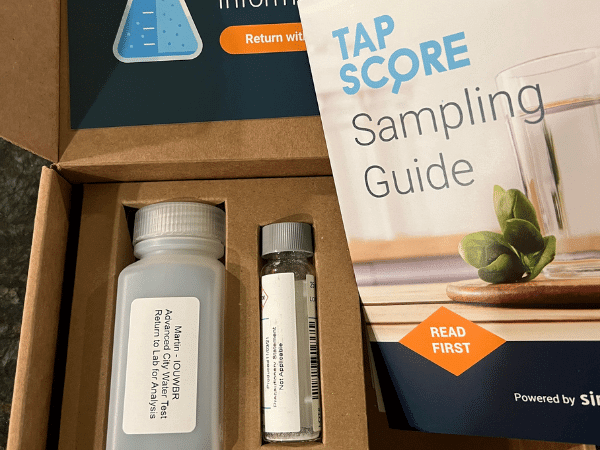If your tap water has a strange, coin-like flavor, you’re not alone. That odd metallic tang might not be harmful — but it could be a sign something’s off in your plumbing or water source.
Whether it’s minerals from your well, corroded pipes, or something sneakier like lead, it’s worth a closer look. And the fix might be easier than you think.
Let’s explore what could be causing that taste — and how to clear it up.
✅ Quick Takeaways
- 🧪 A metallic taste often comes from trace metals like iron, copper, or manganese.
- 🚿 Corroded plumbing or old pipes are common culprits — especially in older homes.
- 💧 Low pH or hard water can also create strange tastes (even if it looks clear).
- 🏡 If you’re on a private well, you may have naturally high levels of minerals or metals.
- 🔍 Testing your water is the fastest way to figure out what’s really going on — and how to fix it for good.
🧪 What’s Behind That Metallic Flavor?

Metal-tasting water usually means something is leaching into your supply — and it’s not always dangerous, but it’s definitely not ideal. The good news? Most causes are easy to identify once you know what to look for.
Below is a cheat sheet to help pinpoint what might be affecting your water 👇
| 🥄 Cause | 💡 What It Means |
|---|---|
| Copper | Common in corroded plumbing — especially in older homes with copper pipes. |
| Iron | May leave rust stains or an earthy, metallic aftertaste — often from wells or aging lines. |
| Manganese | Similar to iron, but often paired with dark stains or a bitter taste in groundwater. |
| Zinc | Usually from galvanized plumbing or corroded fixtures — gives a sharp, tangy flavor. |
| Hard Minerals | High calcium and magnesium can make water taste “off” or chalky. |
| Low pH | Acidic water can dissolve metals from your pipes — raising both taste and risk. |
Most of these causes are harmless in small doses, but some (like lead or corroded copper pipes) need fast attention. If you’ve noticed new or worsening taste issues — especially alongside staining or plumbing problems — don’t ignore it. A quick test can reveal a lot.
⚠️ Could It Be Harmful?

Not all metallic-tasting water is dangerous — minerals like iron and magnesium are essential for health. But when other metals creep in, especially through pipes or acidic conditions, the risks go up.
Here’s a rundown of what’s safe and what’s not 👇
| ⚠️ Contaminant | 💡 Possible Health Effects |
|---|---|
| Iron & Manganese | Usually harmless — but manganese in high levels can affect memory or behavior in kids. |
| Copper | Can cause stomach upset or headaches when levels exceed EPA limits. |
| Zinc | Too much can lead to nausea or metallic aftertaste — rare in treated water. |
| Low pH Water | Can erode pipes and leach metals into your water — damaging teeth or plumbing. |
| Lead | Neurotoxic even in tiny amounts — especially dangerous for kids and pregnant women. |
🧠 If you’re worried about lead, here’s a helpful guide to spotting signs of lead in your tap water. Even small doses can add up fast, especially in older homes.
And if you’re using a private well, don’t wait — the CDC recommends annual water testing for pH, metals, and other contaminants that could cause health problems.
🧪 How To Test for Metallic Contaminants

If your water tastes off, the only way to know what’s really in it is to test. Whether you’re on city water or a private well, pinpointing the cause saves time (and money) when choosing the right fix.
Here’s how different testing methods compare 👇
| 🔍 Method | 💡 What It Tells You |
|---|---|
| City Water Report | Details mineral levels, treatment chemicals & lead risks — ask your utility for the latest version. |
| DIY Test Kit | Quick check for metals, pH, and hardness — useful but not always precise. |
| Certified Lab Test | Professional-grade results for metals, lead, and pH — best option for detailed insight. |
📬 Need a quick answer from home? We recommend Tap Score’s mail-in test kits — they’re lab-reviewed, easy to use, and help match filters to your water quality. It’s worth knowing what’s really behind that metallic tang.
🛠️ How to Fix That Metallic Taste in Tap Water

Once you know what’s causing that metal flavor — whether it’s iron, low pH, or corroding pipes — the fix usually isn’t complicated. The right filter or softener can make your water taste fresh again (and protect your plumbing, too).
Let’s break down your options 👇
| 🔧 Solution | 💡 Best For |
|---|---|
| 🧂 Water Softener (Salt-based or TAC systems) |
Removes hard minerals like calcium and magnesium that can give water a weird taste |
| 🧊 Sediment Filter (Great for well water) |
Catches rust particles (ferric iron) that may be floating in older pipes or well water |
| 🌀 Iron Filter (Oxidizing whole-house systems) |
Treats higher levels of dissolved iron and manganese in private wells |
| 💧 Reverse Osmosis (Point-of-use under sink) |
Removes trace metals, lead, and off-tasting minerals — great for drinking and cooking |
| 🧱 pH Neutralizer (Calcite filters) |
Raises acidic pH to stop corrosion and reduce metal leaching from pipes |
🚫 Bottled water might be a short-term fix, but the right filtration system is better for your wallet and the environment. Whether you go all-in with a whole-house filter or keep it simple with a point-of-use option, getting rid of that metallic taste is easier than you think.
✅ Final Thoughts
Metal-tasting tap water isn’t always dangerous — but it’s never pleasant. Whether it’s caused by trace metals, aging pipes, or low pH, the right solution can make your water taste clean again and protect your home in the process.
💡 The smart move? Test your water first, then match your fix to the real cause — not the guess. From softeners to pH boosters to powerful filters, you’ve got more options than ever.
No one should have to settle for water that tastes like pennies. 💧 Now you’ve got the tools to fix it.
 115 people found this helpful. Was this guide helpful to you?
115 people found this helpful. Was this guide helpful to you? 

